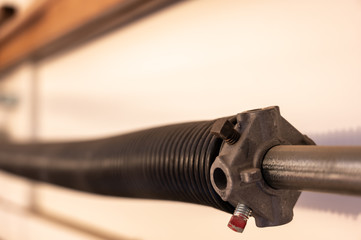
If you have a garage door that doesn’t open or close properly, you may need to repair the spring or cables. There are a few ways to repair a spring, including removing the tension on the spring and unloading the spring. The tension can be unloaded by removing the set screws, which will allow the tension to fall onto the winding bar. Unloading the tension will cause the winding bar to point to the floor or against the door. To replace the spring, you can insert a second winding bar into the winding cone. You can remove the first one by pushing it up, removing it, and replacing it with a new one. The two winding bars will then be unloaded one-quarter turn at a time.
If you’ve noticed that the spring on your garage door is loose, it may be time to replace it. While torsion springs are easier to lubricate and maintain, extension springs can develop wear over time.
There are a variety of ways to get replacement extension springs. You can go online and look for the specific springs you need. You can either search for them by model number or part number. The model number is usually found on the sticker on the garage door.
The first step in replacing extension springs is determining the amount of weight the broken spring is affecting the door. This measurement is difficult without an analog scale, as a digital scale will not react to changes in weight due to a door binding in its tracks. Next, you’ll want to measure the weight of the broken spring using an analog scale placed underneath the broken spring side.
Extension springs are similar to traditional springs in that they stretch and extend with the movement of the garage door. The garage door is normally supported by two extension springs, one on each side. To maintain an even load, the extension springs must be evenly distributed across the door. Ideally, the springs should match the door’s height.
There are two types of springs for garage doors: extension springs and torsion springs. Torsion springs are stronger and last longer than extension springs. Torsion springs are more efficient and have less maintenance.
If you need to repair the spring of your garage door, the cable drum should be removed from the door first. Afterward, you need to remove the old spring. You should carefully measure the size of the spring coils by placing a measuring hook between the two coils. Then, divide the measurement by twenty or forty to find out the wire diameter.
To make sure that the drum is properly aligned, you can try to lift the door manually. If the cable is slack, it will slip out of the groove and fall to the floor. Hence, it is advisable to replace the cable with two new springs. This will keep the tension in the cables until you can repair the broken spring.
You should also check the cables for rust. Those that are rusted will weaken over time due to constant exposure to moisture and dirt. When they become heavily weakened, they will break, damaging the door and anything underneath. So, it is advisable to monitor the cables monthly. If the cables are still not in good shape, you should consider replacing them with higher-quality cables. For example, you should choose cables with zinc-aluminum coating and thicker diameters.
The cables should be reinstalled with care. Before replacing the cable, you should make sure that the drum has the right size and is not too tight. Be sure to tighten the set screws properly. Otherwise, the cable drum may spin and cause damage. Also, you must be careful not to over-tighten the cable drum, as this can cause the torsion tube to crimp.
There are three types of cable drums: high-lift, standard-lift, and vertical-lift. High-lift cable drums are higher than standard-lift drums. The raised portions of the drum keep the garage door balanced while opening and closing.